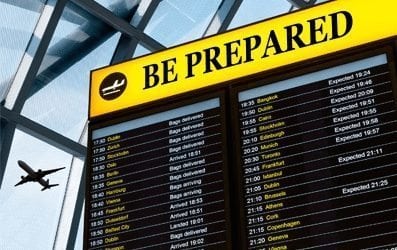
Previous articles in this series covered the following topics in the “General Information about X” (where “X” is the country/ies I will be visiting) document I prepare for every trip outside the U.S.
- Part 1: obtaining foreign currency, currency-related scams, etc.,
- Part 2: choosing, using and protecting the “plastic” you carry with you,
- Part 3: tipping etiquette in your destinations and
- Part 4: cultural sensitivity and staying on the right side of the law.
In the 5th and final article in this series, I will address communication in the country/ies you will be visiting.
Verbal
In our increasingly digital age, communication is becoming both easier and trickier than ever. If you are “connected,” apps on your smartphone provide two-way translation so you can understand directional signs, read menus, etc.. Call me “old school” (and you’d probably be right!), but I prefer to master a limited number of key phrases in the language of the country/ies I will be visiting. I prepare a vocabulary sheet before my trip and commit the keywords and phrases on it to memory so I don’t have to enter pieces of speech I am likely to use repeatedly into my cell phone in a shop or restaurant where (if I need it) I may or may not have access to the Internet. Experience has taught me that locals (who are usually more conversant in English than I will ever be in their native tongue) truly appreciate the simplest effort to use their language. We communicate far more than “Hello” when we greet a local in their own language; doing so conveys respect and being respected is universally appreciated and usually reciprocated.
After I have developed my trip itinerary, these are the steps I follow to develop a “key vocabulary/pronunciation” section for my “General Information about X” document:
- I identify the situations I expect to encounter in which I will be most likely to want or need to initiate a conversation or respond to a local. Will I be using public transport? Will I be shopping? Will I be dining out?
- Next, I make my way to the Treksplorer blog and identify the English words and phrases I expect I will need to use, given my plans, from the list found there.
- Then I group these words and phrases by function (e.g., obtaining directions) or settings (e.g., dining out),
- Finally, I go to Google Translate, enter the English word/phrase I want to translate, copy the resulting translation and paste it into my document.
Here’s an example of a very simple list of words and phrases I’ve used for a short visit to France:
Key Vocabulary/Pronunciation for France
French vowels often have accents which usually affect pronunciation; e.g., the letter e without an accent is often pronounced like the a in alone, as in le (the). However, with the addition of an accent aigu, é, it is pronounced like the ay in day, as in thé (tea). The letter e can also have an accent grave, è, and is then pronounced like the e in met, as in père (father). Nasal vowels are also important in French. In French, when the letter n or m follows a nasal vowel, it is not fully pronounced. For example, the French word bon (good) sounds like the English b plus the nasal o in song. The letter n is not pronounced. Although final consonants often aren’t pronounced in French, they sometimes are when the following word begins with a vowel or silent h; e.g,, the word nous (we) is pronounced noo.
| English | French | English | French | |||||||
| Greetings | ||||||||||
| Hello/good morning | Bonjour! | Good evening (after 6) | Bonsoir! | |||||||
| yes | oui | no | non | |||||||
| How are you? | Comment allez-vous? | Very good/Fine | (Tres) bien | |||||||
| I’m sorry/Excuse me | Excusez-moi | Good-bye | Au revoir | |||||||
| Directions | ||||||||||
| Where is/are… | Où est/sont…? | the Metro (subway) | le métro | |||||||
| the exit | la sortie | the restroom | les toilettes | |||||||
| Right | droit | left | gauche | |||||||
| Numbers | ||||||||||
| 1 | un | 6 | six (sees) | 11 | onze | 100 | cent (sohn) | |||
| 2 | deux | 7 | sept | 12 | douze (dooz) | 200 | deux cent | |||
| 3 | trois | 8 | huit (wheat) | 13 | treiz (trays) | 300 | trois cent | |||
| 4 | quatre (cart) | 9 | neuf | 20 | vingt (vehn) | 400 | quatre cents | |||
| 5 | cinq | 10 | dix | 50 | cinquante | 500 | cinq-cents | |||
| Dining out | ||||||||||
| Please | s’il vous plaît | breakfast | Petit-déjeuner (dayzhornay) | |||||||
| (to call waiter) | Monsieur/Madame | the menu | le menu | |||||||
| appetizers | les hors-d’œuvre/entrées | main course | le plat principal | |||||||
| dessert | le dessert | the check | l’addition | |||||||
| bread | le pain (pah) | butter | le beurre (brr) | |||||||
| white wine | vin blanc | red wine | vin rouge | |||||||
| cup of coffee (with milk) | un café (au lait) | a table for four | Une table pour quatre personnes | |||||||
| We have a reservation for four | Nous avons un reservation… (“un” is almost silent) | |||||||||
| I like my steak rare/raw | J’aime mon steak saignant | …medium/…well done | a point (pwa)/bien cuit (kwi) | |||||||
| Basic Phrases | ||||||||||
| Thank you/thank you very much | Merci (beaucoup) | |||||||||
| I don’t understand | Je ne comprends pas (zhun compruhn pah) | |||||||||
| I don’t speak French | Je ne parle pas Francais | |||||||||
| Do you speak English? | Parlez vou Anglais (ahnglay)? | |||||||||
| Is the tip included? | Est-ce que le service est compris? (Es kuh…eh compree_ | |||||||||
| How much is it? | Combien ça coûte ? (kom-bjanne sar coot?) | |||||||||
| I’m looking for… | Je cherche (zheu share-sh) | |||||||||
| Days of the Week | ||||||||||
| Friday | Vendredi (vahn-druh-dee) | Saturday | Samedi (sahm-dee) | |||||||
| Sunday | Dimanche (dee-mahnsh) | Monday | Lunedi (loon-dee) | |||||||
| Tuesday | Mardi (mahr-dee) | |||||||||
“Lost in translation”
True story…. We were in a café on the Champs-Elysses when my wife needed to use the restroom. Summoning up her best pronunciation, she caught the attention of a server and asked, “Ou sont les toilettes (oo sahnt leh twa-lets)?” The server, probably with a twinkle in his eye, gave her directions in perfect French. Of course, she didn’t understand a word he said! As it turns out, the server appreciated her effort and was just having a bit of fun with her. He then pointed her in the right direction and we all had a good laugh! The point is that one doesn’t need to be fluent or even conversant in order to build good will with those whose country and culture you have chosen to visit – and shouldn’t that be a desirable outcome of travel?
Apps
It’s hard to beat Google Translate in my book (free on both Android and iOS platforms) since it now allows you to point your camera at text printed in dozens of languages and obtain an instant translation – extremely useful for “reading” menus, instructions, signs, etc. It also can be used offline to translate more than 50 languages. If you’re visiting China, Japan or Korea, the waygo app provides the same functionality and is also available for free from both the App Store and Google Play.
Telephone
Let’s start off by acknowledging that there is no single best answer to the often-asked question, “What is the best cell phone service to use when traveling?” The carrier that provides the best service where one lives may not be the carrier that provides the “best” (whatever “best” means to you – cheapest, fastest, etc.) service in the country/ies to which your travels take you. Nor am I any kind of authority on the advantages and disadvantages of the four (4) major U.S. carriers, emerging technologies (like Project Fi), or swapping out sim cards. But I do know how to find good, current information and am eager to share it with my readers. Nomadic Matt swears by T-Mobile (see Why T-Mobile is the Best Phone Carrier for U.S. Travelers) while Tiffany from the “One Mile at a Time” blog swears by Google’s Project Fi (see The Best Cell Phone Plan for International Travel). Android Central posted a great article, International data overseas: How AT&T, T-Mobile, Sprint, Verizon and Project Fi compare in July, 2016; see also Global roaming: which carrier is best? Rebtel allows users to make free or inexpensive calls from most anywhere to both mobile devices and landlines without needing a WiFi connection. My personal favorite solution, however, is to stick to the Internet as much as possible and use Skype. Like I said, call me “old school” and you wouldn’t be far from the truth.
Written
As ubiquitous as Wi-Fi hotspots are (and we can only expect them to become ever more common), a little advance preparation can spare painful headaches. Case in point…. I’m writing this article (or, more truthfully, trying to) on a cruise ship in the middle of the Pacific Ocean. I signed up for the full voyage Internet package (touted to be “the fastest Internet at sea”) ahead of time at a daily rate that, while not exorbitant, is roughly the equivalent of the cost of four (4) days at home. I called Guest Services for my password soon after we boarded and — voila! — I was connected and had no problem accessing my e-mail. I was a happy camper…for a while! Fast forward two (2) days. I could still log in to my e-mail account (our lifeline to our families back home), I could “see” new e-mails in my Inbox but, frustratingly, I could no longer “click” on them to read the message. What was going on here?
Apparently, my e-mail client, to protect my security, disables certain functionality when I attempt to log in more than so many miles from my “normal” location. Yikes; I didn’t anticipate this! Fortunately, the workaround in this situation was cumbersome but it allowed me to do everything I planned. All I had to do is perform any of the denied functions from the ship’s Internet cafe. I uploaded documents to Google Drive so I could write and edit to my heart’s content — I just couldn’t do so from the privacy and convenience of my stateroom.
Moral of the story? Check with your ISP long before departure so you can make alternate plans if necessary which might include:
- designating your travel laptop as a “trusted device” (Outlook, Hotmail),
- obtaining (a) verification code(s) from your ISP,
- forwarding e-mail from your primary client to another while you’re away from home,
- using a VPN,
- develop back-up plans (e.g., printing out key documents ahead of time, using cloud storage, etc., etc.)
Text Messages
WhatsApp, Viber and Hangouts are probably the three most popular messaging apps. Which one you use is probably more a matter of personal preference than functionality. Just make sure you have downloaded and updated the app(s) well before departure and ensured that those with whom you plan to communicate using your app(s) of choice have also installed and know how to use the app(s).
Summary
Well, there you have it. Travel, especially international travel, involves uncertainty. And uncertainty, while exhilarating, can also be stressful. I prefer to minimize stress in order to maximize enjoyment. My “General Information for X” (where “X” is the country/ies I will be visiting) is far from perfect and is a work in progress (as the unexpected e-mail challenges encountered on my current trip described above demonstrate). I (and your fellow readers) would appreciate you sharing preparation tips for your adventures. Happy travels!
I organize things; it's what I do! I enjoy the natural adrenaline high of travel as much as the next person but I also try to limit the likelihood that the surprises I experience along the way will be unpleasant ones. To this end, I spend more hours than most preparing for each trip. Fortunately for me, I enjoy the anticipation of travel as much as the experience of it. A primary objective of my blog contributions will be to share with my readers the "systems" and approaches I have developed over the years that have allowed my bride of 34 years and me to cross off a majority of our bucket list items. I've been a minister, nonprofit agency executive, professor and consultant. My "job" in retirement is planning our next trip.













